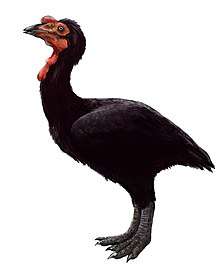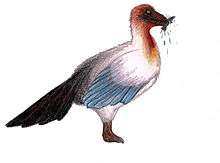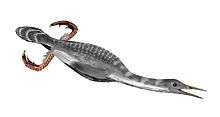Microraptoria
Microraptoria (Greek, μίκρος, mīkros: "small"; Latin, raptor: "one who seizes") is a clade of basal dromaeosaurid theropod dinosaurs. The first microraptorians appeared 125 million years ago in China. Many are known for long feathers on their legs and may have been semi-arboreal powered fliers, some of which even capable of launching from the ground.[2] Most microraptorians were relatively small; adult specimens of Microraptor range between 77–90 centimetres long (2.53–2.95 ft) and weigh up to 1 kilogram (2.2 lb), making them some of the smallest known dinosaurs.[3][4]
| Microraptoria | |
|---|---|
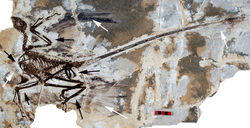 | |
| Fossil specimen of a Microraptor, with white arrows pointing at preserved feathers | |
| Scientific classification | |
| Kingdom: | Animalia |
| Phylum: | Chordata |
| Clade: | Dinosauria |
| Clade: | Saurischia |
| Clade: | Theropoda |
| Family: | †Dromaeosauridae |
| Clade: | †Microraptoria Senter et al., 2004 |
| Genera | |
| Synonyms | |
| |
Description
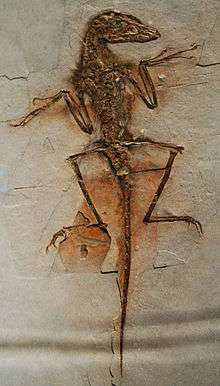
Microraptorians were a group of basal dromaeosaurids (popularly known as 'raptors') with slender proportions and long limbs. With the exception of Hesperonychus from the late Cretaceous of North America, all microraptorians have been found in the Yixian and Jifuotang Formations of Liaoning county, China, hence why microraptorians are sometimes referred to as "Liaoning dromaeosaurs". These formations (collectively known as the Jehol group) have been dated to the early Cretaceous and at that time would have been part of a temperate wetland ecosystem threatened by frequent volcanic eruptions. Like other dromaeosaurids, microraptorians were carnivores with relatively large, serrated teeth and an hyper-extendable second toe equipped with a curved claw.
Size and proportions
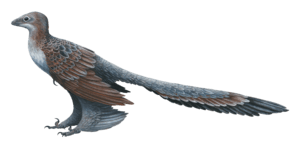
Most microraptorians were small dinosaurs, with taxa like Microraptor and especially Zhongjianosaurus being among the smallest non-avian dinosaurs known. However, some microraptorians, such as Tianyuraptor and Changyuraptor, were larger and similar to other dromaeosaurids in size. Many microraptorians also had long and robust arms and legs, in contrast to the stockier eudromaeosaurs, although long arms are not universal to the group since the basal microraptorian Tianyuraptor had unusually short arms by dromaeosaurid standards.[5] Considering this, it is likely that the small size and long wings of some microraptorians are an example of convergent evolution with other small paravians and early birds such as Anchiornis and Archaeopteryx.
Feathers
The fossilization conditions of the Jehol group are very accommodating to the preservation of soft structures in fossils, and as a result many microraptorians have been preserved with a covering of feathers. Not only have long, advanced feathers been preserved on the arms and tails of many specimens, but a few species even have long feathers on their legs. This condition has also been seen in other paravians such as Anchiornis, and has caused these kinds of dinosaurs to be labelled as "four-winged dinosaurs". The largest known "four-winged" dinosaur, Changyuraptor, is a microraptorian. It is possible that some microraptorians such as Microraptor were able to use these wings to glide or take off from the ground.[6][2]
Characteristic features[5][7]
Microraptorines can be distinguished from other dromaeosaurids due to the following features:
- A maxilla laterally sculpted by small pits.
- A very short manual phalanx III-2.
- A shortened first digit of the hand.
- A splatulate (rounded) pubic symphysis.
- A metatarsal III with a pinched proximal end.
- A slender metatarsal II.
In addition, several features are present in microraptorines with the exception of Tianyuraptor, which is believed to be a basal member of the clade:
Classification
Microraptoria is usually classified as a clade of dromaeosaurids. Senter and colleagues expressly coined the name without the subfamily suffix -inae to avoid perceived issues with erecting a traditional family-group taxon, should the group be found to lie outside Dromaeosauridae proper.[8] Sereno offered a revised definition of the sub-group containing Microraptor to ensure that it would fall within Dromaeosauridae, and erected the subfamily Microraptorinae, attributing it to Senter et al., though this usage has only appeared on his online TaxonSearch database and has not been formally published.[9]
The cladogram below follows a 2012 analysis by paleontologists Phil Senter, James I. Kirkland, Donald D. DeBlieux, Scott Madsen and Natalie Toth.[10]
| Dromaeosauridae |
| |||||||||||||||||||||||||||||||||||||||||||||||||||||||||||||||||||||||||||
See also
References
- "Archived copy". Archived from the original on 2017-04-11. Retrieved 2017-04-11.CS1 maint: archived copy as title (link)
- Dececchi, TA; Larsson, HC; Habib, MB (2016). "The wings before the bird: an evaluation of flapping-based locomotory hypotheses in bird antecedents". PeerJ. 4: e2159. doi:10.7717/peerj.2159. PMC 4941780. PMID 27441115..
- Holtz, Thomas R. Jr. (2011) Dinosaurs: The Most Complete, Up-to-Date Encyclopedia for Dinosaur Lovers of All Ages, Winter 2010 Appendix.
- Chatterjee, S.; Templin, R.J. (2007). "Biplane wing planform and flight performance of the feathered dinosaur Microraptor gui" (PDF). Proceedings of the National Academy of Sciences. 104 (5): 1576–1580. doi:10.1073/pnas.0609975104. PMC 1780066. PMID 17242354.
- Zheng, Xiaoting; Xu, Xing; You, Hailu; Zhao, Qi; Dong, Zhiming (2010-01-22). "A short-armed dromaeosaurid from the Jehol Group of China with implications for early dromaeosaurid evolution". Proceedings of the Royal Society of London B: Biological Sciences. 277 (1679): 211–217. doi:10.1098/rspb.2009.1178. ISSN 0962-8452. PMC 2842677. PMID 19692406.
- Han, Gang; Chiappe, Luis M.; Ji, Shu-An; Habib, Michael; Turner, Alan H.; Chinsamy, Anusuya; Liu, Xueling; Han, Lizhuo (2014-07-15). "A new raptorial dinosaur with exceptionally long feathering provides insights into dromaeosaurid flight performance". Nature Communications. 5: ncomms5382. doi:10.1038/ncomms5382. PMID 25025742.
- Longrich, Nicholas R.; Currie, Philip J. (2009-03-31). "A microraptorine (Dinosauria–Dromaeosauridae) from the Late Cretaceous of North America". Proceedings of the National Academy of Sciences. 106 (13): 5002–5007. doi:10.1073/pnas.0811664106. ISSN 0027-8424. PMC 2664043. PMID 19289829.
- Senter, Phil; Barsbold, R.; Britt, Brooks B.; Burnham, David B. (2004). "Systematics and evolution of Dromaeosauridae (Dinosauria, Theropoda)". Bulletin of the Gunma Museum of Natural History. 8: 1–20.
- Sereno, P. C. 2005. Stem Archosauria—TaxonSearch Archived 2009-01-15 at the Wayback Machine [version 1.0, November 7, 2005
- Senter, P.; Kirkland, J. I.; Deblieux, D. D.; Madsen, S.; Toth, N. (2012). Dodson, Peter (ed.). "New Dromaeosaurids (Dinosauria: Theropoda) from the Lower Cretaceous of Utah, and the Evolution of the Dromaeosaurid Tail". PLOS ONE. 7 (5): e36790. doi:10.1371/journal.pone.0036790. PMC 3352940. PMID 22615813.
- "Expand and Life history of a basal bird: morphometrics of the Early Cretaceous Confuciusornis" Luis M Chiappe, Jesús Marugán-Lobón, Shu'an Ji & Zhonghe Zhou (2008)
External links
- 1.http://www.paleodb.org/cgi-bin/bridge.pl?a=basicTaxonInfo&taxon_no=143267
- 2.http://www.taxonsearch.org/dev/taxon_edit.php?tax_id=483&Action=View
- 3.http://theropoddatabase.blogspot.com/2010/03/article-1311-means-lewisuchinaeidae-is.html
| Wikispecies has information related to Microraptoria |
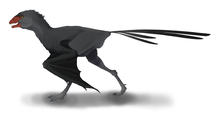
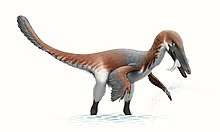
.png)
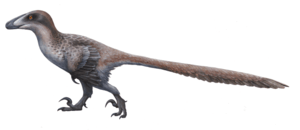

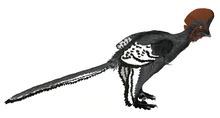
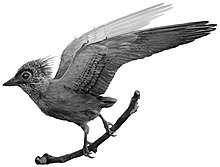

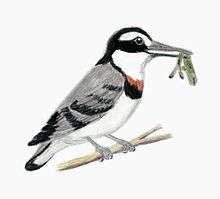
.png)
